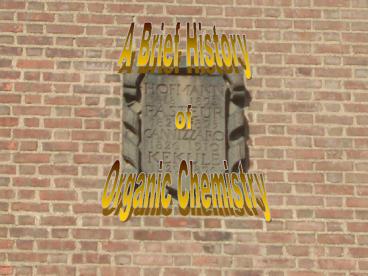A Brief History - PowerPoint PPT Presentation
1 / 29
Title:
A Brief History
Description:
Title: No Slide Title Author: Fred Ziegler Last modified by: Fred Ziegler Created Date: 8/17/2001 2:11:00 PM Document presentation format: On-screen Show – PowerPoint PPT presentation
Number of Views:156
Avg rating:3.0/5.0
Title: A Brief History
1
Title
A Brief History
of
Organic Chemistry
2
Phlogiston/Stahl
The Phlogiston Theory
metal heat calx of metal Ø
e.g., zinc zinc oxide Ø
phlogiston (Ø) is lost
calx charcoal(Ø) heat metal (fixed
air)
phlogiston (Ø) is gained
Problem
phlogiston has a negative mass!
Georg Ernest Stahl (1660-1734)
3
Priestley
The Co-Discovery of Oxygen
Trained in the ministry
Studies on the nature of air - 1775
Mercurius calcinatus heat Mercury
dephlogisticated air
HgO heat Hg O
Recognized the role of oxygen in the life cycle
Told Lavoisier of his findings
Joseph Priestley (1733-1804)
Held to the phlogiston theory until his death
4
Lavoisier
Lavoisier and Combustion
Quantitative methods
Mass is conserved
Combustion is not a loss of phlogiston but a gain
of oxygen.
Traité de Chimie - 1789
Antoine-Laurent Lavoisier (1743-1794) and His
Wife (Marie-Anne-Pierrette
Paulze,
1758-1836), 1788 Jacques-Louis David (French,
1748-1825)
Dual names for salts
Guillotined 1794
www.metmuseum.org
5
Dalton/Atomic Theory
Atomic Theory
1. Elements composed of indivisible atoms
2. Elements have defined and different masses
3. Elements combine in simple numerical ratios -
Law of Multiple Proportions
John Dalton (1766-1844)
6
Rule of Greatest Simplicity
The Rule of Greatest Simplicity
For Water
But 1g of H / 2 x 4g of O Formula HO2
Or 2 x 1g of H / 16g of O Formula H2O
7
Dylan Thomas
"One Christmas was so much like another, in those
years around the sea-town corner now and out of
all sound except the distant speaking of the
voices I sometimes hear a moment before sleep,
that I can never remember whether it snowed for
six days and six nights when I was twelve or
whether it snowed for twelve days and twelve
nights when I was six."
"A Child's Christmas in Wales" --- Dylan Thomas
8
Berzelius
Electrochemical Theory
Chemical analysis
Modern symbols of the elements
Discovers Ce, Se, Th, Si, Zr, etc.
Defines isomerism
Electrochemical Theory (Dualism)
Jons Jacob Berzelius (1779-1848)
9
Electrochemical Theory
Electrochemical Theory (Dualism)
Salts
10
Wohler 1828
The Beginning of the End for Vitalism
1828 - Converts ammonium cyanate CH4N2O
(inorganic)
Into urea
CH4N2O (organic)
Friedrich Wöhler (1800 - 1882)
An example of isomers
Begins the downfall of Vitalism
11
Artificial urea
On the Preparation of Artificial Urea
I cannot, so to say, hold my chemical water and I
must tell you that I can make urea without
needing to have kidneys, or anyhow, an animal,
be it human or dog.
1828 - Wöhler to Berzelius
For more from the wry pen of Wöhler.
12
Radical Theory
Radical Theory
Refined chemical analysis
Developed laboratory instruction
Trained many of the chemists of the day
Proponent of Radical Theory along with Dumas
Justus Liebig (1803-1873)
13
Benzoyl Radical
The Benzoyl Radical
1832 - Liebig and Wöhler
Benzoyl hydride
C7H5O - H
(Oil of bitter almond, Benzaldehyde)
C7H5O - OH
Benzoyl hydroxide
(Benzoic acid)
Benzoyl chloride
C7H5O - Cl
Benzamide
C7H5O - NH2
14
Dumas/Liebig 1837
1837 - Dumas and Liebig Note on
the Present State of Organic Chemistry
In mineral chemistry the radicals are simple in
organic Chemistry the radicals are compound
that is all the difference. The laws of
combination and of reaction are otherwise the
same in these two branches of chemistry.
Leicester and Klickstein, A Source Book of
Chemistry, 1400 - 1900. Harvard, 1952)
15
Substitution Theory
Substitution Theory
1838 - chlorination of acetic acid
C4H4O2 Cl6 C4HCl3O2 H3Cl3
C 6, O 16
C2H4O2 3Cl2 C2HCl3O2 3HCl
J. B. Dumas (1800 -1884)
16
Ammonia Type
Type Theory
1850 - The ammonia type
August Wilhelm von Hofmann
(1818-1892)
17
Water Type
The Water Type 1850 - 1852
Alexander Williamson (1824-1904)
An expanded version of the ether story
18
Valence/Frankland
Valence
1852 - recognizes the ability of N, P, As, and
Sb to combine with 3 and 5 other elements.
1857 - Kekule develops the idea of valence with
carbon compounds.
Edward Franklin (1825 - 1899)
19
Kekule
1858 - Tetravalence of carbon
1865 - Structure of benzene
1861 - Lehrbuch der Organischen Chemie
Friedrich August Kekule (1829-1896)
20
Kekules 19 formulas for acetic acid
Kekule's 19 formulas for
acetic acid (C2H4O2) from his
Lehrbuch der Organischen Chemie 1867 (pg.
164 165)
21
Couper 1858
1858
Atoms with lines between them
(1831-1892)
22
Loschmidt 1861
Physicist and Chemist
1861 - Diagrammatical Structural Formulae of
Organic Chemistry
Joseph Loschmidt (1821 - 1895)
23
Crum Brown 1865
1865
Alexander Crum Brown (1838-1922)
Atom connectivity
Multiple connections
24
vant Hoff 1874
1874 - The Arrangement of Atoms in Space
Jacobus Henricus vant Hoff (1852 - 1911)
1901 - 1st Nobel Prize in Chemistry
25
Lewiss Cube I
1869 - Mendeleevs Periodic Table
1897 - Thomson Discovers the Electron
1902 - Lewiss Cubic Model of the Atom
(Covalence)
1916 - Lewis Dot Formula
26
Lewiss Cube II
27
Failure of the Cubic Model
Failure of the Cubic Model
28
Quantum Mechanics
Quantum Mechanics leads to ...
Resonance
Hybridization
Molecular Orbital Theory
Linus Pauling (1901 - 1994)
The Nature of the Chemical Bond (1939)
29
The End
The End






![[PDF]❤️DOWNLOAD⚡️ The 1912 Election and the Power of Progressivism: A Brief History with Documen PowerPoint PPT Presentation](https://s3.amazonaws.com/images.powershow.com/10039231.th0.jpg?_=20240525045)


![⚡[PDF]✔ Robert's Rules of Order Fast Track: The Brief and Easy Guide to Parliamentary PowerPoint PPT Presentation](https://s3.amazonaws.com/images.powershow.com/10042746.th0.jpg?_=20240530076)





















